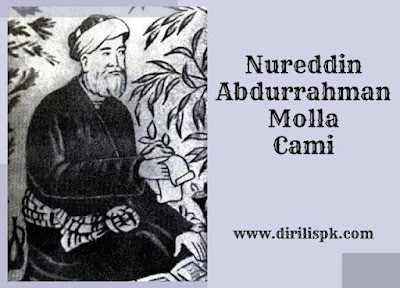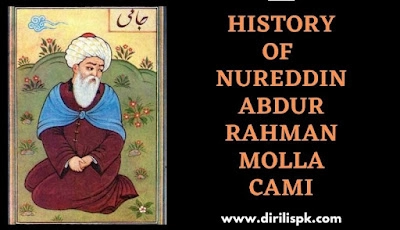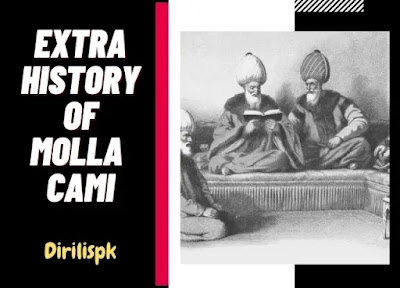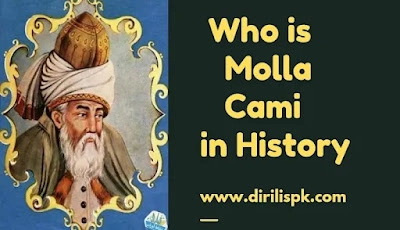Who is Molla Cami? This question invites us to explore the life and contributions of Nureddin Abdurrahman Molla Cami, a prominent figure in Persian literature and Islamic scholarship. Born in 1414 in the city of Jam, Khorasan, Molla Cami’s intellectual journey began at an early age. He was a prolific writer, poet, and theologian, whose works have left an indelible mark on Persian literature and Sufi thought. His most notable works include “Tuhfat al-Ahrar” and “Yusuf and Zulaikha,” which are celebrated for their profound spiritual insights and literary elegance. This article delves into the history of Nureddin Abdurrahman Molla Cami, exploring his early life, his scholarly achievements, and his enduring legacy.
Molla Cami’s influence extended beyond his literary contributions. As a respected Sufi scholar, he played a crucial role in the Naqshbandi Sufi order, guiding many disciples and spreading the teachings of Sufism. His works often reflect his deep spiritual insights and his commitment to the principles of love, humility, and devotion. By examining the history of Nureddin Abdurrahman Molla Cami, we gain a deeper understanding of his impact on both Persian literature and Islamic mysticism.
Nureddin Abdurrahman Câmî was born on 23 Shaban 817 (7 November 1414) in Harcird town of Cam city of Khorasan. He is mostly known as Molla Câmî . In the introduction of his first divan, he says that he took the pseudonym Câmî in relation to the city of Cam and as an expression of his respect for the memory of Ahmed-i Nâmekī-yi Câmî.
Who is Molla Cami? Islamic scholar and poet; Molla Câmî is the life of Nureddin Abdurrahman Câmî with his full name.
His grandfather, Shamseddin Muhammad, who migrated from Isfahan to Khorasan, here Imam Muhammad b. He married the daughter of a descendant of Hasan al-Shaybani, from this marriage his father Nizameddin Ahmedwas born. Cami started his primary education with his father. When his father went to Herat and became a professor at the Nizamiye Madrasa (823/1420), he continued his education there. He read the basic works of Arabic language and literature from Mevlânâ Cüneyd-i Usûlî, one of the famous scholars of his time. Afterwards, he continued the lessons of famous scholars such as Ali es-Samarkandi, a student of Sayyid Sharif al-Cürcânî, and Şehâbeddin Muhammed el-Câcermi, a student of Teftâzânî. Later, he went to Samarkand, which became a great science center during the time of Uluğ Bey, and stayed there for nine years. He took riyâziyyat lessons from Kadızâde-i Rûmî from Bursa at Uluğ Bey Madrasa. Meanwhile, Mevlana also benefited from the lessons of Fethullah-i Tebrizî. He won the admiration of everyone thanks to his sharp intelligence, talent, ability to explain scientific issues and ability to express his views very clearly. In his Reshahad, Kâşifî reports astonishing memories about the education of the Mosque. Famous astronomy and mathematics scholarWhen Ali Kuşçu went to Herat, he asked Câmî difficult questions about astronomy.
Although he was well-versed in all the sciences of his time at a young age, these sciences did not satisfy Câmî. On his return from Samarkand, he joined Sa’deddin-i Kasgari , one of the Naqshbandi sheikhs . After his death, he was attached to his successor, Hâce Ubeydullah Ahrar. He met with Ubeydullah several times. He also kept in constant contact with her by correspondence. Câmî, who praised him at every opportunity in various parts of his poetic and prose works, wrote a long elegy in his death. There is no doubt that the influence of Ubeydullah Ahrar on the Mosque was greater than that of other Naqshi sheikhs.
Molla Cami’s Love Of Ehl-i-Beyt :
The mosque left Herat to go on pilgrimage in 877 (1472). During this journey, while in Baghdad, some Shiites falsified the part of the Silsiletü’ẕ-ẕeheb mathnawi about the love of Ehl-i-bayt and wanted to use it against the Mosque, but the Mosque said that loving the Ahl-i-bayt was an order of the Qur’an and Silsiletü’ He silenced his opponents by reading the chapters of ẕ-ẕeheb about the Ahl al-Bayt, and won the appreciation of the scholars there. He went to Tabriz on his return from the pilgrimage. Although Akkoyunlu ruler Uzun Hasan wanted to stay in Tabriz, he left there. He returned to Herat on 18 Shaban 878 (8 January 1474). He taught Arabic language and literature, hadith and tafsir lessons in the madrasah that Sultan Hüseyin Baykara had built for him . Herat on Friday, 18 Muharram 898 (November 9, 1492)He died in His funeral was held with the participation of all the notables of the time, especially Hüseyin Baykara and Ali Şîr Nevâî , and he was buried next to the tomb of his sheik Sa’deddin-i Kaşgarî.
After the death of Câmî, Ali Şîr Nevâî wrote a long elegy in the style of tefibibend, and also wrote a work called Hamsetü’l-mütehayyirîn about his life. One of his followers, Süheylî, wrote a long elegy and expressed his sadness at his loss.
There is no information about Cami’s first marriage. It is understood from one of his poems that he lost all of his family members and lived alone for a while after this incident. Later, he married one of the two daughters of Hâce Kelân, the eldest son of his mentor Sa’deddin-i Kaşgarî, and Fahreddin Safî, the author of Reşehât, married the other. In the sources, it is mentioned that he had a poet, scholar and a brother named Mevlânâ Muhammed, who was a master in history and music, and Cami confirms this information in the elegy he wrote on his death at a young age.

The Timurlis Protected :
Câmî, whose education life passed during the reign of Mirza Shahruh (1404-1446), came into contact with the Timurid palace during the reign of Mirza Ebü’l-Kāsım Babur (1448-1457). Câmî, dedicating a work on the enigma to Babur, later composed his first divan during the reign of Sultan Abu Said (1451-1468) and wrote some Sufi treatises. The years when his artistic life and scientific and spiritual authority were at their peak is the period of Hüseyin Baykara (1470-1505). Although all the sultans and palace dignitaries had endless respect for him, he never tried to be nice to the rulers. Although the mosque praised rulers such as Hüseyin Baykara, the patron of science and art, he never went to extremes and used an encouraging and educational style to those he praised.
The mosque was not only known in Transoxiana and Khorasan, but also gained the respect of sultans, scholars and poets in a wide area from India to the Balkans. Although Fatih Sultan Mehmed sent Hodja Atâullah Kirmani to Aleppo with a gift of 5000 gold in order to invite the Mosque to Istanbul on his way back from the pilgrimage, this invitation did not take place because the Mosque had left just before Kirmani’s arrival. For the second time, Fatih sent an envoy to Câmî with valuable gifts and asked him to write a work comparing the views of theologians, philosophers and mystics. Upon this, he wrote Câmî ed-Dürretü’l-fâḫire, but when the work was sent to him, Fatih passed away. . In the divan of the mosque, there is a poem in the style of masnavi describing the conquests of Fatih Sultan Mehmet.
Letter With Sultan Beyazit-II :
The letters written between Fatih’s son, Beyazıt II, and Cami, clearly show the respect and love that the sultan had for him. Cami answered Beyazıt’s letter with a eulogy and praised him in another ode. He wrote the third part of Silsiletü’ẕ-ẕeheb on behalf of Beyazıt the second. It is understood from his works that he had friendly relations with rulers such as Karakoyunlu Cihan Shah and Akkoyunlu Uzun Hasan and Yâkub Bey.
Relationship With The Students Of The Period :
Câmî also had close friendships with poets such as Ali Şîr Nevâî and Süheylî, who were the amirs of the Baykara period. Nevâî and Süheyli were among his disciples. Câmî declared on every occasion that he loved and appreciated Nevâî, praised him in his masnavi named Ḫırednâme-i İskenderî, and Nevâî respectfully remembered him in his mathnawis. Abdulgafûr-i Lârî, the most famous of his disciples, named the annotation that he wrote for his master’s Nefehât, Tekmile-i Nefehâtü’l-üns. This work is an important source about Câmî’s life and personality.
Câmî, who always enjoyed learning and teaching from his youth to the end of his life, did not lag behind this noble occupation for a single moment. The Arabic grammar book al-Fevâʾidü’ż-Żiyâʾiyye, which he prepared for his son a few months before his death, is a proof of this. In one of his rubâîs, he states that there is no better friend and partner in the world than a book.
In his divan and masnavis, he explained that verse is superior to prose, the qualities of good and bad poetry, and how poetry should be, and made accurate evaluations by using the “poetry criticism” method in accordance with today’s understanding. Câmî, who mentions the types of poetry he is interested in in a masnavi and states that he finally settled on masnavi and respectfully mentions the names of his masters in masnavi, says that prose and poetry are very effective means in revealing the truth in proportion to their compliance with the Shari’a, otherwise they will be the source of all evils. According to him, poetry should be used to show people the right way and should not be used as a tool for personal interests.
The Last Great Representative Of Persian Poetry :
Considered the last of the greatest masters of Persian poetry, Câmî made extensive use of his superior poetic talent as well as his deep understanding of religious, literary and intellectual sciences and Sufism in all his poems, masnavis and especially mystical masnavis, and showed the power to explain the subjects he dealt with in a very comfortable and simple language. It is claimed that he was one of the first pioneers of the poetry movement known as “Indian style” (sebk-i Hindi).
Câmî’s main literary works are in Persian. He also wrote Arabic works and showed his mastery of this language by translating a eulogy by Ferezdak, one of the Arab poets, into Persian.
The works of Câmî, who had very close relations with the Turks due to the Turkish neighborhood he belonged to, spread throughout the Turkish world even when he was still alive, and attracted the attention of the scholars and poets of that period. The fact that his important works have been translated into Turkish shows his influence on Turkish literature.

He Has The Belief Of Ahl-i-Sunnett :
Câmî, who completed his education in science centers such as Samarkand and Herat, with the theologians of the Ash’ari sect according to the principles of Shafi’i fiqh, showed that he was of this opinion by explaining the Islamic principles in accordance with the beliefs of Ahl as-sunna in his masnavi called İʿtiḳādnâme. Câmî, who is a sincere mystic and demonstrates this with his exemplary life, preferred to teach in a madrasa and train students instead of working as a sheikh in a dervish lodge, even though he received guidance from his sheikh Sa’deddin-i Kaşgarî. One of his masters, Câcermi, whom he underestimated by saying “I heard only two useful words from him”, expresses that he regrets his involvement in Sufism. Câmî’s sect lineage reaches Bahâeddin Nakşibend, the founder of the Nakşibendiyye sect, through Sa’deddin-i Kaşgarî, Nizameddin Hâmûş and Alaeddin Attâr.
He established close relations with the leading Naqshi sheikhs of his time, such as Muhammed Parsâ, Ubeydullah Ahrâr, Mevlânâ Fahreddin Luristani, Bahaeddin Ömer Bağıstanî, in addition to his sheikh Kâşgari, and he had a special interest in Muhammed Parsâ and Ubeydullah Ahrar. The fact that Jami was a member of the Naqshbandi sect did not prevent him from benefiting from the members of other sects.
Influence Of The Naksibandiy Section :
The understanding of mysticism based on unity of existence, which was processed by Muhyiddin İbnü’l-Arabî and İbnü’l-Fârız, XV. It was fused with the Sufi understanding of the Naqshbandiyya sect, which was widely spread in the Eastern Islamic world in the 19th century and was also protected by the Timurids, through the Mosque. A treatise to explain the first two couplets in Mevlânâ’s Mes̱nevî, commenting on İbnü’l-Arabî’s Fuṣûṣü’l-ḥike, later summarizing it with the name Naḳşü’l-Fuṣûṣ, commenting on İbnü’l-Fârız’s ode. Câmî, who penned Fahreddîn-i Irâkī’s Lemaʿât with the name of Eşiʿatü’l-Lemaʿât, on the other hand, synthesized Eastern and Western mysticism by writing a work about Nakshi sheiks such as Süḫanân-ı Ḫâce Muḥammed Pârsâ. Brave like a mosque, a mover, Thanks to enthusiastic and agile people, Naqshbandiyya created an environment suitable for giving the most valuable products of the history of Sufism. Although Imam-i Rabbani immediately comes to mind when this sect is mentioned, it is an important issue that should be emphasized that Jami, who is as important as him, perhaps more important than him. Because today, Câmî is known thanks to a grammar book (Molla Câmî) used to be taught in madrasahs.
The mosque explained the difficult issues of mysticism and wisdom in a simple manner befitting a scholar, and represented this profession at the highest level. At the end of the section in which he tells about Hâce Ubeydullah Ahrâr, he says, “When the words and behaviors of the great personalities belonging to the Hacegan sect, especially Bahaeddin Nakşibend and his friends, and their methods in the sect are examined, it is clearly understood that they are completely devoted to the creed of the Ahl as-sunnat sect, and that they follow a path in accordance with the shari’a and sunnah. ” He also expressed his own opinion on this matter. According to Jami, who says that Sufism is superior to the professions of philosophers and theologians, it is only true love that can bring a person to eternal bliss. The “sultan of love” who flirts with all the becomings and manifestations in the realm of existenceis. Both the lover and the loved one are God Himself at every level. Absolute love shines from all manifestations, appears in every comprehension and consciousness, and proofs of the oneness of Allah can be observed in every being in the universe. Jami draws attention to the need to avoid ignorant people disguised as Sufis, who want to confuse the pure minds, as if running away from fire, and explains the characteristics of true Sufism and the true Sufi in order not to fall into their trap.

Works Of Molla Cami :
It is mentioned in the sources that Jami has over forty-five works in Persian and Arabic. However, some of them have not reached the present day. The subjects of his works are Sufism, literature, literary and religious sciences.
A) Poetic Works.
- 1. Sofas.
- 2. Heft Eveng.
- 3. Ḥadîs̱-i Erbaʿîn.
- 4. Risale-i Terceme-i Kelimât-ı Ḳudsiyye.
- 5. Risâle-i Ṣaġīr der Muʿammâ.
B) Prose Works.
- 1. Nefehâtü’l-üns.
- 2. Naḳdü’n-nuṣûṣ fî şerḥi Naḳşi’l-Fuṣûṣ.
- 3. Sharḥu Fuṣûṣü’l-ḥike.
- 4. His wife’atü’l-Lemaʿât.
- 5. Levâʾiḥ.
- 6. Risale-i Tehlîliyya.
- 7. Süḫânân-ı Ḫâce Parsâ.
- 8. Risale fi’l-wujûd.
- 9. Ser-rişte-i Ṭarîḳ-i Ḫâcegân.
- 10. Tafsîrü’l-Ḳurʾân.
- 11. Risâle-i Şerḥ-i Ḥadîs̱.
- 12. Risale der Menâsikü’l-ḥac.
- 13. Shawahidu’n-nubuwwa.
- 14. Bahâristân.
- 15. al-Fevâʾidü’ż-Żiyâʾiyye.
- 16. Risale der ʿilm-i Ḳāfiye.
- 17. Tecnîsü’l-luğat.
- 18. Risale-i Musîḳī.
- 19. Kitâb-ı Ṣarf.
- 20. Risale-i Münşehat.
- 21. Risale-i Kübrâ der Mu’ammâ.
- 22. Risâle-i Mutavassı der Muʿammâ.
- 23. Risâle der Beyân-ı Ḳavâʿid-i Muʿammâ.
- 24. ed-Dürretü’l-fâḫire.
- 25. Şerḥ-i Mîmiyye-i Ḫamriyye-i Fariżıyye.
- 26. Şerḥ-i Ḳaṣîde-i Tâʾiyye-i Fariżıyye.
- 27. Risale der Sharḥ-i Rubâʿiyyât.
- 28. Risâle-i Şerḥ-i Beyt-i Ḫüsrev-i Dihlevî.
- 29. Risâle-i Şerḥ-i Beyteyn-i Mes̱nevî-i Mevlevî.
- 30. Risale fi’l-ʿarûż.
- 31. Risale-i Fihrist.
Conclusion
The history of Nureddin Abdurrahman Molla Cami is a testament to his enduring legacy as a scholar, poet, and Sufi master. His life and works continue to inspire and influence scholars and spiritual seekers around the world. Understanding who Molla Cami was and his historical significance provides valuable insights into the rich tapestry of Persian literature and Sufi thought. His contributions remain a beacon of wisdom and spiritual enlightenment, reflecting the timeless values of love, humility, and devotion.
